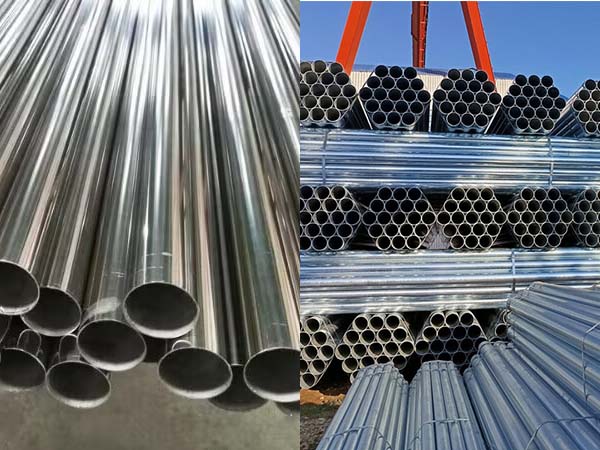In modern industrial and civil buildings, steel pipes remain one of the most important and widely used conveying and supporting materials. It is widely applied in fields such as building structures, fluid transportation, and mechanical manufacturing. With the continuous increase in the usage of steel pipes, the anti-corrosion issue of steel pipes has received more and more attention.
Galvanized steel pipes and
stainless steel pipes, as two common types of anti-corrosion steel pipes, both possess the characteristics of rust prevention and corrosion resistance. Although they are similar in function, their actual utilities vary. Now let's take a look at the differences between galvanized steel pipes and stainless steel pipes

Galvanized steel pipe: By coating a layer of zinc protective layer on the surface of the steel pipe (usually
carbon steel pipe), it effectively protects the steel from corrosion by the external environment. Even if there are scratches or damages around the steel, the surrounding coating will corrode first, forming a layer of zinc oxide or zinc carbonate film on the exposed steel pipe base to prevent the steel pipe base from corroding.
Stainless steel pipe: Stainless steel pipes are made from stainless steel billets or plates through piercing, rolling or welding, and their main properties depend on the stainless steel. Stainless steel is cast from iron, carbon and other elements such as chromium, nickel and molybdenum. It has excellent corrosion resistance and high-temperature resistance. Its anti-corrosion performance mainly depends on the chromium element, which can form a layer of chromium oxide film on the surface of stainless steel. And as the surface oxide layer is reconstructed, the oxide film will self-repair.
Main differences
The differences in material composition and manufacturing processes
Galvanized steel pipe: It is made of carbon steel or iron as the base material, and a layer of zinc is covered on its surface through processes such as hot-dip galvanizing or electro-galvanizing. The zinc layer accounts for approximately 1% of the weight of the steel pipe.
Stainless steel pipe: Composed of iron and at least 10.5% chromium, and with the addition of alloying elements such as nickel and molybdenum, a self-healing chromium oxide passivation film can be formed on the surface.
Anti-corrosion performance
Galvanized steel pipe: The zinc layer protects the underlying steel through the sacrificial anode mechanism. However, once the zinc layer is exhausted or damaged, the steel will start to rust. Especially in Marine environments or under conditions of high humidity, the corrosion rate increases significantly. Galvanized coatings will be damaged more quickly under high-temperature and humid conditions. Galvanization is not suitable for continuous humid and high-temperature environments.
Stainless steel pipe: The chromium oxide film formed on the surface of stainless steel has self-repairing ability and can be quickly repaired after damage. It has excellent corrosion resistance to various environments, including seawater, chemical media, and high temperatures.
Service life and durability
Galvanized steel pipes: Their service life can reach 30 to 50 years in medium environments (depending on the thickness of the zinc coating and the environment). The service life is shortened in a highly corrosive environment, and periodic maintenance and zinc recoating are required.
Stainless steel pipes: They have a long service life, generally exceeding 50 years, and have extremely low maintenance requirements. The whole-process recycling is relatively economical.
Appearance and aesthetics
Galvanized steel pipe: The surface is matte grayish white. Over time, it will gradually show signs of rust and mottling, making it very suitable for industrial-style decoration.
Stainless steel pipe: It has a smooth and bright silver appearance, is not prone to discoloration, and has an excellent long-term display effect. It is suitable for decoration or as a visible structural material.
Strength and mechanical properties
Galvanized steel pipe: Its mechanical properties rely on carbon steel and it has good ductility and strength. However, the zinc coating is prone to damage under the influence of welding heat, thereby affecting the processing performance.
Stainless steel pipe: It has remarkable technical strength and an even more outstanding resistance to deformation. The welding process requires professional techniques, and in a high-temperature environment, the oxide film is prone to damage.
Welding and precautions
Galvanized steel pipes: The zinc coating must be properly handled before and after welding; otherwise, toxic zinc fumes will be produced, affecting the welding quality. When workers are welding manually, they should pay attention to wearing protective equipment to prevent poisoning or discomfort symptoms.
Stainless steel pipes: Welding requires temperature control and post-passivation cleaning; otherwise, the passivation film will be damaged, affecting corrosion resistance.
Application field
Galvanized steel pipes: Widely used in outdoor environments, water systems, water supply piping, agricultural drainage, fence facilities and carport construction, etc.
Stainless steel pipes: Widely used in food and beverage, chemical, offshore platforms, medical equipment, precision structures and decoration fields.
Summary
In the modern engineering field, galvanized steel pipes are widely used in ordinary water supply and drainage systems and structural supports due to their low cost, high strength and basic anti-corrosion properties. In contrast, stainless steel pipes, with their self-healing passivation film, excellent corrosion resistance and high-temperature resistance, as well as their hygienic and aesthetically pleasing features, have demonstrated a longer service life and lower maintenance costs in extreme environments such as chemical engineering, Marine, food and medicine, despite their higher cost.
Read more: Galvanized carbon steel pipe vs Stainless steel pipe
